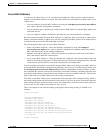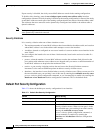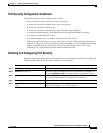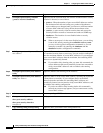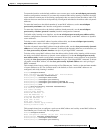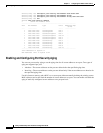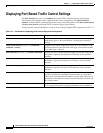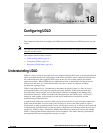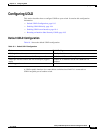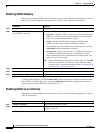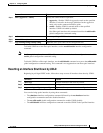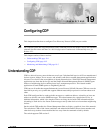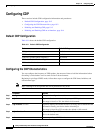
CHAPTER
18-1
Catalyst 2950 Desktop Switch Software Configuration Guide
78-11380-05
18
Configuring UDLD
This chapter describes how to configure the UniDirectional Link Detection (UDLD) protocol on your
switch.
Note For complete syntax and usage information for the commands used in this chapter, refer to the command
reference for this release.
This chapter consists of these sections:
• Understanding UDLD, page 18-1
• Configuring UDLD, page 18-3
• Displaying UDLD Status, page 18-6
Understanding UDLD
UDLD is a Layer 2 protocol that enables devices connected through fiber-optic or twisted-pair Ethernet
cables to monitor the physical configuration of the cables and detect when a unidirectional link exists.
All connected devices must support UDLD for the protocol to successfully identify and disable
unidirectional links. When UDLD detects a unidirectional link, it administratively shuts down the
affected port and alerts you. Unidirectional links can cause a variety of problems, including
spanning-tree topology loops.
UDLD works with the Layer 1 mechanisms to determine the physical status of a link. At Layer 1,
autonegotiation takes care of physical signaling and fault detection. UDLD performs tasks that
autonegotiation cannot perform, such as detecting the identities of neighbors and shutting down
misconnected interfaces. When you enable both autonegotiation and UDLD, Layer 1 and Layer 2
detections work together to prevent physical and logical unidirectional connections and the
malfunctioning of other protocols.
A unidirectional link occurs whenever traffic sent by the local device is received by the neighbor but
traffic from the neighbor is not received by the local device. If one of the fiber strands in a pair is
disconnected, as long as autonegotiation is active, the link does not stay up. In this case, the logical link
is undetermined, and UDLD does not take any action. If both fibers are working normally from a Layer 1
perspective, UDLD at Layer 2 determines whether those fibers are connected correctly and whether
traffic is flowing bidirectionally between the correct neighbors. This check cannot be performed by
autonegotiation because autonegotiation operates at Layer 1.



